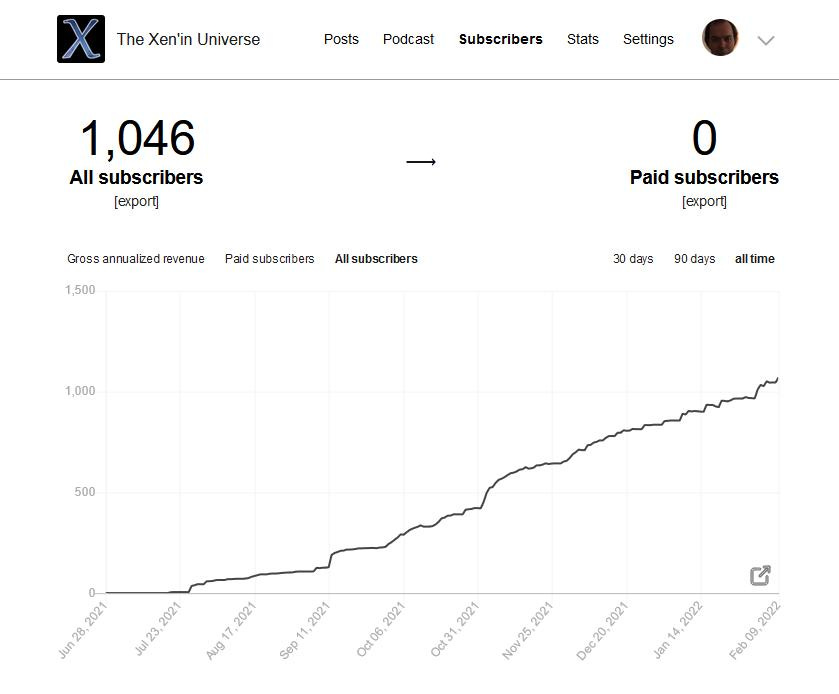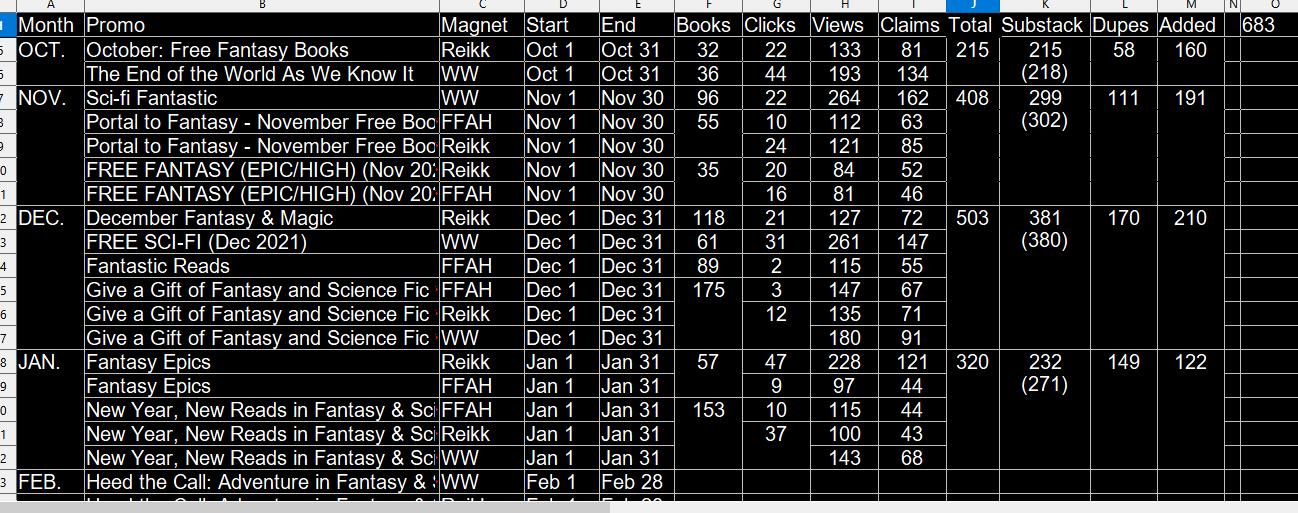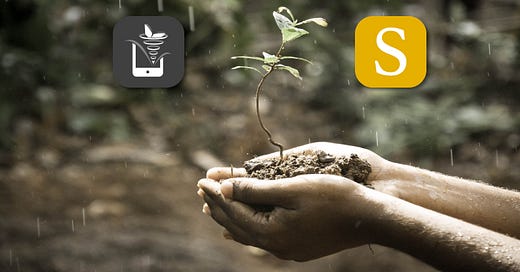So you’ve just started your Substack... or maybe you’ve had one for some time but are still struggling to grow your audience?
A technique that I (and many other authors) usually recommend is to create a reader magnet and take part in group promos, through sites such as Bookfunnel (BF) or StoryOrigin (SO).
These tools were initially designed for novel writers, and are still widely used by them. However, not only is it possible to use them with Substack, I believe they can give even better results for our platform of choice.
But let’s start at the beginning.
1. What is a reader magnet?
It’s really a fancy word for a piece of text. That text can be anything you want it to be... Well, OK, maybe not anything—your grocery list is not likely to draw too many readers.
As the name suggests, the whole purpose of this text is to do just that: draw readers in by offering them something they can read for free... The more likely readers are to like it, the more likely they are to download it.
The text doesn’t need to be something new—you’re welcome to use an older text, maybe even something you’ve already published on your Substack. Popular choices include novels, novellas, and short stories. A collection of shorts can work well too.
One thing to keep in mind is that you need to connect it in some way to your Substack.
Example: if you’re publishing a serial, you can make a magnet from a prequel, or maybe use an origin story for one of your characters.
It doesn’t need to be a huge connection, but you’ll want to avoid a horror story as a magnet if everything you publish on your Substack is military science-fiction, for instance.
Mind you, people would still download your magnet, but they’re less likely to stick around if the contents you email them don’t match what they like. Make sense?
What about non-fiction, you ask? Well, if your Substack is non-fiction, then it would, of course, make more sense that your magnet reflects that with similar content.
Once you’ve decided what content to use and have your cover made, just put it all together in an epub file... and voila! You have a reader magnet.

2. Book swaps and group promos
Now that you have a magnet, you’re probably wondering what the heck you’re going to do with this thing?
Well, that’s where sites like Bookfunnel and StoryOrigin come in.
The concept is rather simple: you mention another author’s book in your newsletter and they’ll do the same with yours.
When a reader clicks on a book cover, it takes them to a landing page for that book. This will display the cover, a blurb, and a link to download said book. If they want the magnet, they’ll have to agree to sign up for your newsletter.
Side note: just like on Amazon, you’ll need a great cover to catch a reader’s attention, then a great blurb to make them want to read your story.
Of course, nothing stops you from cross-promoting with authors you know without going through sites like these. However, these sites provide useful tools to keep track of who is sharing what (and to verify that they’re actually doing it), and how many people are clicking your cover and downloading your book.
With a book swap, it’s a one-on-one exchange with a given author. You can have multiple swaps in your newsletter, though I don’t recommend doing more than four. On Substack, I’d even keep that number lower (I usually do only one or two.)
Group promos use a different approach. When you join one—usually focused on a specific genre or theme—, your book gets listed along with others (it can be anything—10, 150, or even more) on a common landing page. You then share in your newsletter (as do all those other authors) a banner with a link pointing to that landing page.
If you’re a non-fiction author, you’ll be happy to hear that there ARE some non-fiction group promos available. However, I won’t lie: there are not as many options... which means results might not be quite as good as with fiction. You’ll have to experiment with it over a couple of months to see if it is worth it for you or not.
3. Bookfunnel vs. StoryOrigin
Using either site requires a minimal fee of $10 per month—but, as you’ll see below, it usually is worth the spend.
Which you sign up for depends on what you want to do.
StoryOrigin tends to give better results with swaps, while Bookfunnel is much better with group promos.
Which means the two sites are somewhat complementary. So, ideally, you’d want to use both. However, if your budget is tight, I’d suggest going with Bookfunnel first, as it does give overall better results.
To illustrate my point, I’ve added 561 subscribers just from the group promos I joined in my first three months with BF. Some will drop off, of course, but retention is much higher than with a more traditional newsletter (I’ve tested both.)

Caveat: I got those numbers using two magnets—one a science-fiction short story, the other an epic fantasy novella—and folks sign up for a newsletter where I post free short stories in both those genres (and a few others.) Your mileage may vary depending on what you have to offer.
4. Downsides
The main downside is that neither site offers integration with Substack.
Integration means that when someone signs up to your newsletter through BF or SO, their address automatically gets added to your newsletter.
This option is not available with Substack (so don’t bother paying for that service on BF.) Instead, you’ll have to download a CSV file with the new addresses (BF does make this process slightly easier than SO, by the way) then import them into Substack.
Another downside is that after a while, the number of subscribers you get through this method will dip. This is because these sites give you access to a large pool of readers, but it is not infinite. There will come a point when you’ll have reached all the readers you could.
This is why it is better to take a monthly subscription rather than an annual one. When you see your numbers drop, cancel your subscription. Wait a few months before you go back (new authors sign up all the time, bringing their readers with them.) Maybe try the other site during this time—you’ll be tapping into a different pool of readers, though there will be some overlap.
5. Other options
I’ve focused on StoryOrigin and Bookfunnel, but there are other sites like them out there, such as MyBookCave. But how successful you are with them highly depends on the number of authors that use those sites. And it’s clear that BF and SO are the more popular and most widely used of these.
6. Other uses
It should be noted that these sites can also be used to do a variety of other things.
For instance, SO lets you give out ARC copies and track when reviews are posted, while BF allows you to add multiple pen names under one account.
One other popular usage is to provide “direct downloads,” meaning people can grab your book without having to subscribe to your newsletter.
This can be useful if you just want to give away a book and need to host it somewhere. You could, of course, do this with a cloud service (like Dropbox or Google Drive) but using BF or SO allows you to have a nice little landing page, plus (in the case of BF specifically) to view download stats.
7. Links
All this wouldn’t be much use, would it, if I didn’t provide all the relevant links! So here you go...
I’ll also include Bookclicker (another site like BF/SO) though the little I’ve tried it left me with the impression of an over-complicated interface, so no idea how effective it really is.
8. Further reading
Not enough information for you? No problem.
I always highly recommend reading StoryOrigin’s guide to building a newsletter using swaps and group promos—even if you don’t end up using SO. It’s a great resource! See for yourself:
https://storyoriginapp.com/blog/email-marketing-guide
Fellow Substack author Erica Drayton has also published a few articles about BF and SO. This how-to is a good place to start if you want to learn the gritty details of how it all works.
And if you still have questions about these platforms, by all means, post them below and I’ll do my best to answer.
Here’s to us all growing our newsletters in 2022 (and beyond.)
Header image: royalty-free stock image from Pixabay + BF & SO logos.
Alex S. Garcia is a bilingual writer from France who publishes free Science-Fiction and Fantasy short stories on his Substack newsletter, The Xen’in Universe, plus a weekly Space Opera serial for paid subscribers.








Terrific primer! I’m still shocked at how well BF works for building a fiction reader list.
Super helpful! I'm working on re-tooling my substack and plan on trying out BF when that's done. I'll have to come back and report my results!